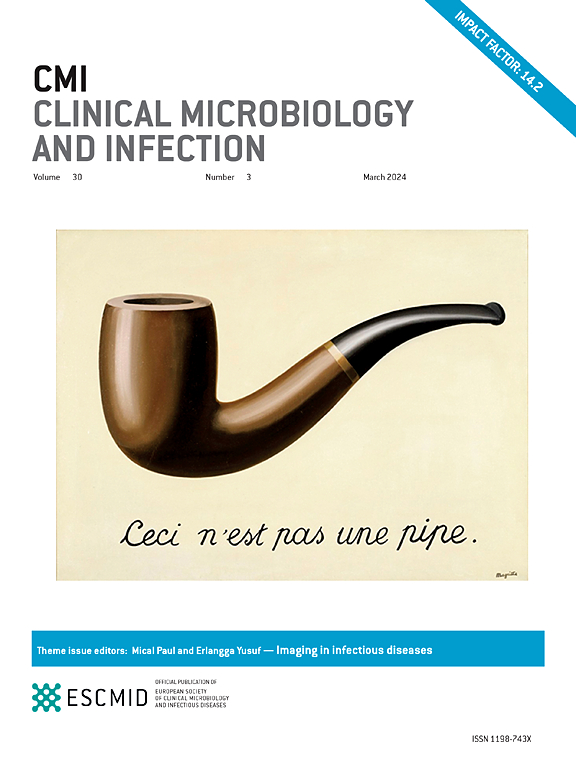通过蛋白质组学检测包柔氏菌:偏头痛红斑活检的辅助诊断工具。
IF 10.9
1区 医学
Q1 INFECTIOUS DISEASES
引用次数: 0
摘要
目的:我们在莱姆包虫病的背景下开发了靶向蛋白质组学,作为一种新的直接诊断工具,用于检测迁延性红斑患者皮肤中的包柔氏菌蛋白质。如果效果令人满意,这种蛋白质组学技术可与培养和/或 PCR 技术一起用于播散性感染,在播散性感染中,检测包柔氏病菌是证明活动性感染的关键。在这些感染中,诊断是间接的,主要依赖血清学:我们招募了 46 名莱姆包虫病患者和 11 名对照组患者,并为每名患者采集了两份皮肤活检样本。方法:我们招募了 46 名莱姆包虫病患者和 11 名对照组患者,并为每名患者采集了两份皮肤活检样本。一份活检样本用于 B. burgdorferi sensu lato PCR 和培养,另一份活检样本用于基于质谱的靶向蛋白质组学研究。蛋白质组学选择了六个感染标记物:OspC、鞭毛蛋白、烯醇化酶、脂蛋白gi|365823350、DpbA和GAPDH:结果:从活检组织中培养鲍曼不动杆菌提高了方法的灵敏度。在纳入分析的患者中,通过蛋白质组学、PCR 和培养,分别有 61%(28 人)、61%(28 人)和 46%(21 人)被检测为阳性。PCR 和蛋白质组学是互补的。OspC和鞭毛蛋白是蛋白质组学最常检测到的感染蛋白质标记物,在一些患者中,鞭毛蛋白最多可检测到9个肽段:结论:通过蛋白质组学可以识别皮肤中的细菌制造者。我们的方法可用于诊断蜱传疾病,如莱姆包虫病:试验注册:ClinicalTrials.gov Identifier:NCT02414789。本文章由计算机程序翻译,如有差异,请以英文原文为准。
Detection of Borrelia burgdorferi sensu lato by proteomics: a complementary diagnosis tool on erythema migrans biopsies
Objectives
We have developed targeted proteomics in the context of Lyme borreliosis (LM) as a new direct diagnostic tool for detecting Borrelia proteins in the skin of patients with erythema migrans. If satisfactory, this proteomic technique could be used in addition to culture and/or PCR for disseminated infections where Borrelia detection is essential to demonstrate active infection. In these infections, the diagnosis is indirect and relies mainly on serology.
Methods
We recruited 46 patients with LM and 11 controls and collected two skin biopsies from each patient. One biopsy was used for Borrelia burgdorferi sensu lato PCR and culture and the other one was for targeted mass-spectrometry-based proteomics. Six markers of infection were selected for proteomics: Outer surface protein C (OspC), flagellin, enolase, lipoprotein gi|365823350, decorin binding protein A, and glyceraldehyde-3-phosphate dehydrogenase.
Results
Culturing Borrelia from the biopsies increased the sensitivity of the methods. Among the patients included for analysis, 61% (28 patients), 61% (28), and 46% (21) were detected as positive by proteomics, PCR, and culture, respectively. PCR and proteomics were complementary. OspC and flagellin were the most frequently detected protein markers of infection by proteomics, which in some patients, detected up to nine peptides for the flagellin.
Discussion
It is possible to identify bacterial makers from the skin by proteomics. Our approach can be used to diagnose tick-borne diseases such as LM.
Trial registration
clinicaltrials.gov identifier: NCT02414789.
求助全文
通过发布文献求助,成功后即可免费获取论文全文。
去求助
来源期刊
CiteScore
25.30
自引率
2.10%
发文量
441
审稿时长
2-4 weeks
期刊介绍:
Clinical Microbiology and Infection (CMI) is a monthly journal published by the European Society of Clinical Microbiology and Infectious Diseases. It focuses on peer-reviewed papers covering basic and applied research in microbiology, infectious diseases, virology, parasitology, immunology, and epidemiology as they relate to therapy and diagnostics.

 求助内容:
求助内容: 应助结果提醒方式:
应助结果提醒方式:


